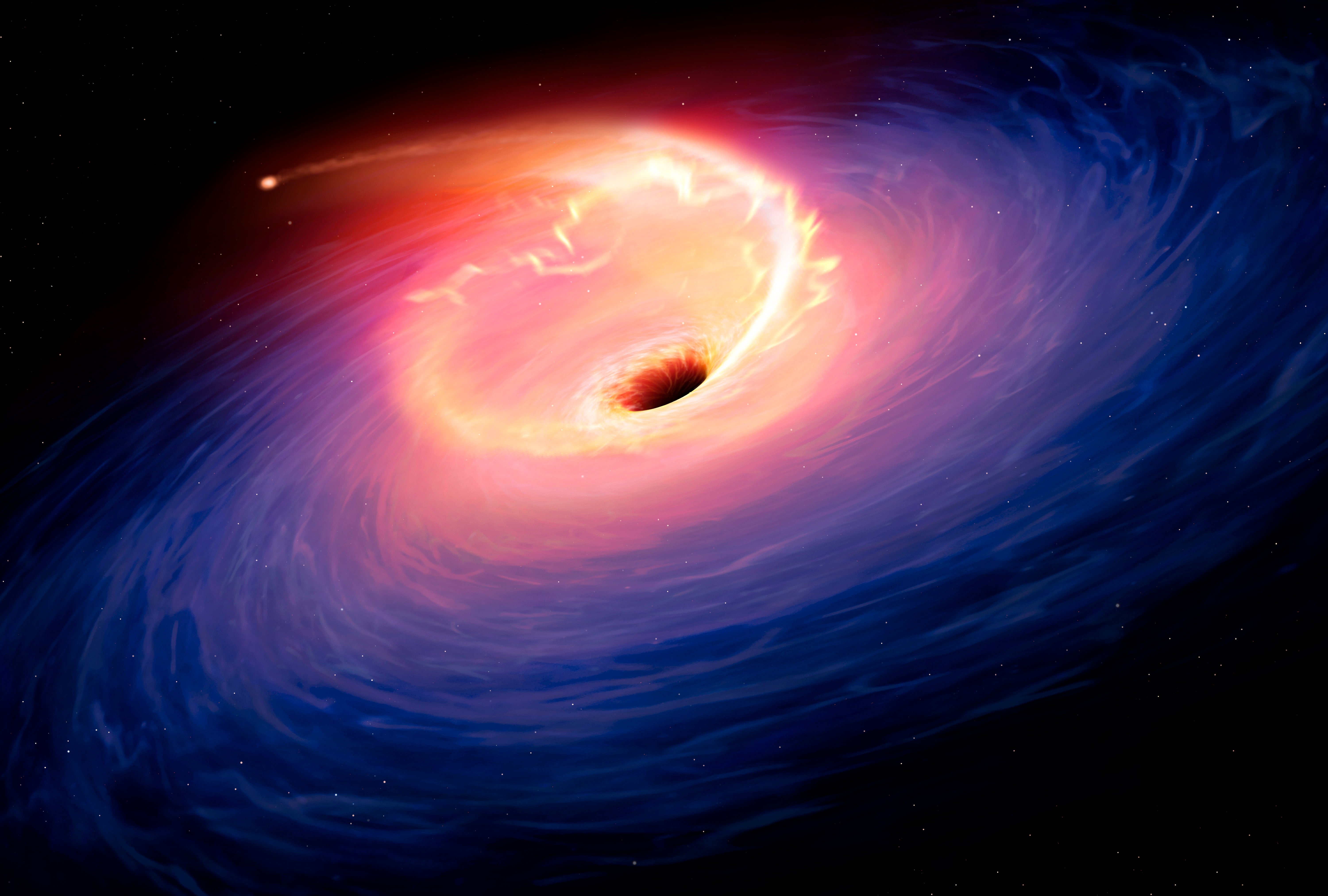
Most people probably know that the universe is full of elementary particles—but not everyone knows that it is also full of extremely fast stars moving freely through space like barracuda through the ocean. These stars are ejected by gravitational slingshots located at the focal point of galaxy mergers—where a pair of supermassive black holes coalesce while kicking stars out of the host galaxy, like a batter hitting a series of home runs out of the park. As the black hole pair tightens, its orbital speed rises, providing an even more powerful swing. Eventually this process launches some stars up to the speed of light in accordance with Albert Einstein’s special theory of relativity, making them what astrophysicists call “relativistic.”
In 2014 I and my former postdoc James Guillochon calculated the abundance of free-fall relativistic stars in the vast space between galaxies and the difficulties involved in detecting them at the large distances. It must be thrilling to live on a planet orbiting one of these ejected stars and to witness its trip through space. The journey starts at the center of the parent galaxy, continues through many points of interest, out to the edge of the galaxy’s halo within one million years, and culminates in intergalactic space, passing by cosmological destinations over billions of years—all of which we can barely see through telescopes.
These relativistic stars represent the most attractive travel packages that intergalactic tourist agencies can offer, and they also provide health benefits. Traveling close to the speed of light entitles you to the perk of time dilation—slowing down the natural aging process of all travelers relative to those they left behind.
Even in the absence of a galaxy merger, stars tugged by the strong gravity near a black hole at the center of a galaxy could also reach the speed of light. Half of the 2020 Nobel Prize in Physics was jointly awarded to Reinhard Genzel and Andrea Ghez for their program, which monitors stars moving at a few percent of the speed of light near the Milky Way’s supermassive black hole, Sagittarius A*. Relativistic stars are expected to be gravitationally bound to black holes at the centers of many other galaxies.
If relativistic stars in a galactic nucleus run into each other, the resulting head-on collision can produce a blast much more energetic than a typical supernova—an explosion from the collapse of a massive star after its nuclear fuel is exhausted. In order for the two-star collision to occur at nearly the speed of light, the central black hole must weigh more than 100 million suns. At lower masses, as is the case with black holes like Sagittarius A*, which weighs “only” four million suns, the strong tidal force of the black hole spaghettifies stars when they come close to it. The disrupted stars are then spread into a stream of gas long before they can get close enough to the black hole’s horizon to reach the speed of light, as shown in the Ph.D. thesis of my former student, Nick Stone.
At higher masses and at its event horizon, the gravitational tide—which scales inversely with the square of the black hole mass—is sufficiently weak so as not to disrupt a passing star. Stars that orbit at large distances from either type of black hole move at lower speeds, and their collisions result in weak explosions, as I showed in a preprint paper with my former graduate student Doug Rubin and in a follow-up preprint paper with Shmuel Balberg and Re’em Sari, both at the Hebrew University of Jerusalem.
What happens close to the most massive black holes, where stars can orbit at nearly the speed of light without being tidally disrupted? In a new paper,my current graduate student Betty Hu and I show that collisions of stars near these large black holes trigger the most energetic explosions in the universe, releasing up to thousands of times more energy than normal supernova explosions. These superluminous explosions in galactic nuclei would be detectable at the edge of the universe by the Legacy Survey of Space and Time (LSST) camera at the Vera C. Rubin Observatory, which is scheduled to start its operation within a couple of years.
There is yet another way to launch stars from galactic centers at high speeds. A pair of bound stars passing close to a supermassive black hole can be separated by its gravitational tide. One of the stars is kicked closer to the black hole while the other is ejected at a high speed, as predicted theoretically by Jack Hills in 1988. The kick that one star gets toward the black hole could account for the closest stars to Sagittarius A*, which was discovered by Genzel and Ghez. The ejection of their companions is the likely origin of the hypervelocity stars discovered in 2005 by Warren Brown and his collaborators in the halo of the Milky Way. These hypervelocity stars move at up to 2 percent of the speed of light and potentially carry planets with them. Planets that are freed by the ejection process constitute a population of hypervelocity planets, as theorized in a 2012 paper I wrote with my former student Idan Ginsburg.
All in all, galactic nuclei offer launch sites for the fastest habitable platforms that nature offers for free. It would not be surprising if advanced technological civilizations choose to migrate toward galactic centers for the same reason that astronauts and spectators flock to Florida’s Cape Canaveral during rocket launches. With that perspective in mind, searches for extraterrestrial intelligence should check for radio signals coming from riders of hypervelocity stars. We might also notice celebratory fireworks from their relatives at the galactic center whenever a high-speed star is shot out of there.
This is an opinion and analysis article.



